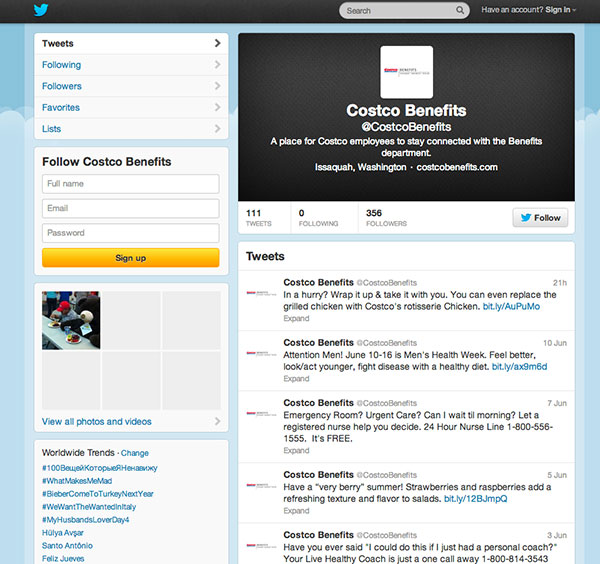Your Employee Communication Strategy is Lacking and Ideas on How to Fix it
By The Bailey Group Marketing
Published June 14, 2013
Effective employee communication is a vital aspect of the employer-employee relationship. You have a strategy for many other aspects of your business, so why not have one for employee communication?
Think about it for a second. At our core, we love to communicate. It’s why social networks are as popular as they are. It’s why people can’t seem to put their phones down at all hours of the day and night. When we communicate with one another, we feel connected.
The same concept translates to how you’re communicating with your employees. Effective communication shows employees that they are valued by the company; conversely, lack of communication can make them feel under-appreciated fostering discontentment and low morale. Poor communication may also suggest to employees indifference to their performance and result in lower productivity.
According to MetLife’s 11th Annual Study of Employee Benefits Trends, more than 1/3 of employees grade their benefits communications a C or below. In that same study, employees who awarded A or B grades to their company’s benefits communications find their benefits much easier to understand. Don’t you want to be the employer with A and B grades instead of C’s!?
With all the possible channels for communication today, there are plenty of opportunities to supply employees with timely and accurate company news and information. Let’s dig in.
Some of the Different Mediums for Employee Communication
In today’s day and age, communication options are seemingly endless. However, it’s important to balance technological channels with face-to-face contact, so that executives and managers stay visible and accessible to employees.
Costco uses Twitter to communicate benefits information to employees
Examples of technological communication channels:
- Videos (online or broadcast on televisions around the building)
- Blogs (written by CEOs or other executives)
- Social Media (Twitter and Facebook are great places to start)
- Podcasts
- Intranet
- Hotline telephone number for emergencies or important announcements
- Newsletters
- Bulletin boards (online or physical)
Examples of face-to-face interactions:
- Town hall meetings
- Company or department-wide meetings
- CEOs or executives walking around chatting with employees
- One-on-one meetings between employees and their direct supervisor
When to Communicate with Employees
Communication is important on several levels, ranging from groundbreaking company information to day-to-day interaction.
- Significant news: This includes layoffs, mergers/acquisitions, management changes, new product announcements, bankruptcy, organizational crises and company re-organization. It is essential to inform employees of such news promptly, truthfully and transparently. Nothing hurts employee morale and loyalty more than hearing about something on the morning news rather than from their employer.
- Quarterly and yearly goals, initiatives and achievements: Give employees access to company sales data, upcoming and ongoing goals or initiatives, and details on the future direction of the company. They want to know that they are working for a healthy, financially solvent company, and they likely will be interested to hear what direction decision makers are taking the company.
- One-on-one meetings: All employees should have the opportunity to meet one-on-one with their immediate supervisor periodically to discuss expectations, current projects and concerns or questions on either end. This meeting should be separate from any performance evaluations in order to foster maximum openness.
- Praise and recognition: Employees want their hard work to be recognized, so make sure your management team finds ways to praise large accomplishments of teams or individuals. Whether it’s a personal email, an in-person handshake or an announcement on the company intranet, don’t let employee achievement go unnoticed.
- New hires and promotion: Keep employees in the loop by announcing new hires and promotions to the company or branch. This will help new employees feel welcome and will further the recognition for promoted individuals.
- Ongoing company news or information: This could be anything from how current projects are progressing to dates for the upcoming company picnic to updates in a company policy. Through your chosen communication channels, make sure employees are always informed on any information relevant to them. The more involved they are with the company, the more loyalty they will likely have.
Fostering Two-way Communication
Getting information out to employees is essential, but hearing their thoughts, concerns and ideas is important too. Not only will they feel like the company values their opinion, but they could provide some excellent feedback for future changes or improvements. Here are just a few ideas for encouraging open communication:
- During company or department-wide meetings, allow time at the end for a question and answer portion. Here, executives need to be sure to answer employees honestly and directly, even if the answer is, “I’m not sure” or “I can’t discuss that now and here’s why…”
- When possible, deliver news in smaller group settings to allow for discussion and conversation among employees and management.
- Conduct periodic employee opinion surveys and keep them anonymous to encourage candid responses. Analyze the results collectively and work to improve items of concern among employees.
- Have an open-door policy for all management levels. Employees should feel comfortable expressing their ideas, concerns or suggestions with a supervisor.
No Magic Bullet
None of these ideas on their own are a magic bullet solution to fixing your communications strategy overnight. Effective communication takes time, effort and a plan — which is why many companies stumble in this area. You must build the magic bullet piece by piece.
How does your company communicate with their employees? What have you found works the best? Which method is a waste of time? Let us know in the comments below!




